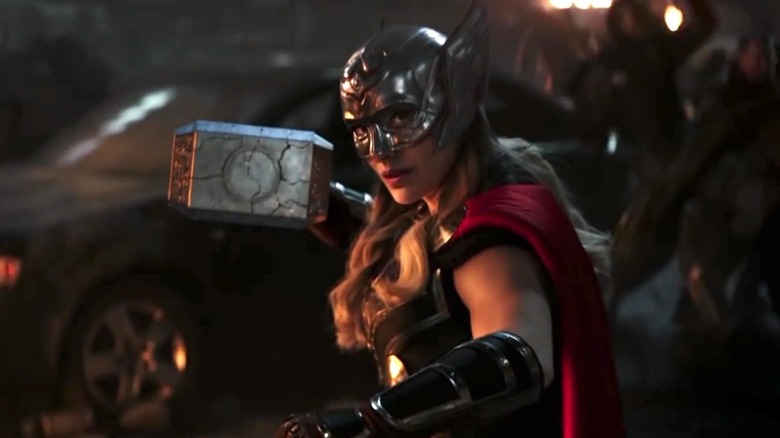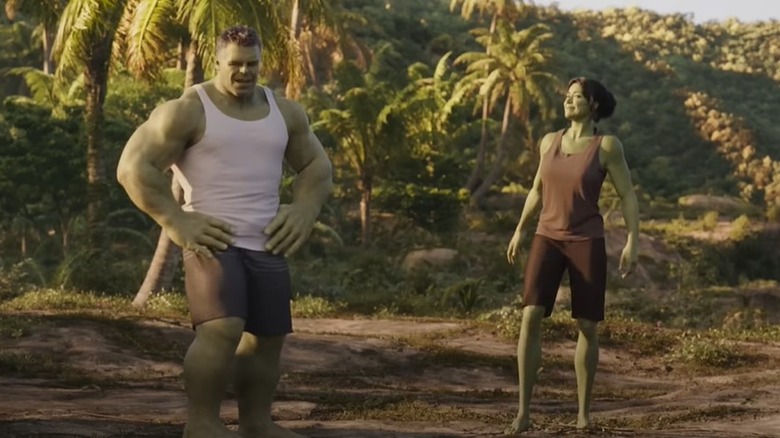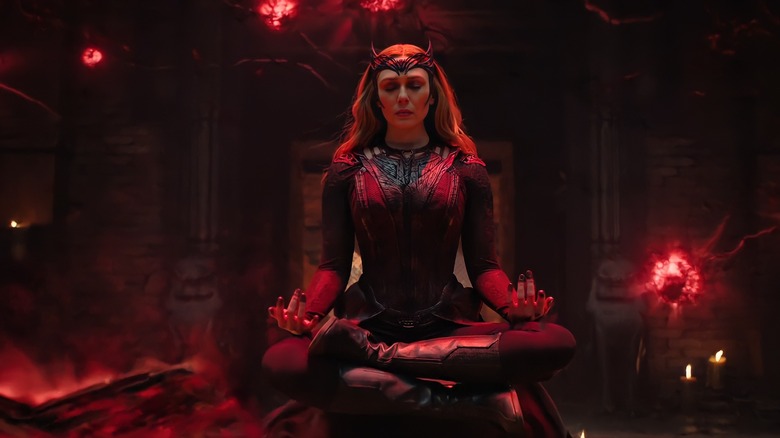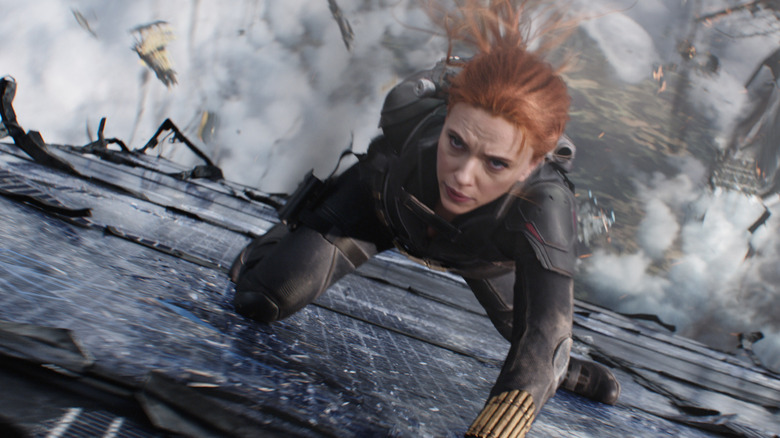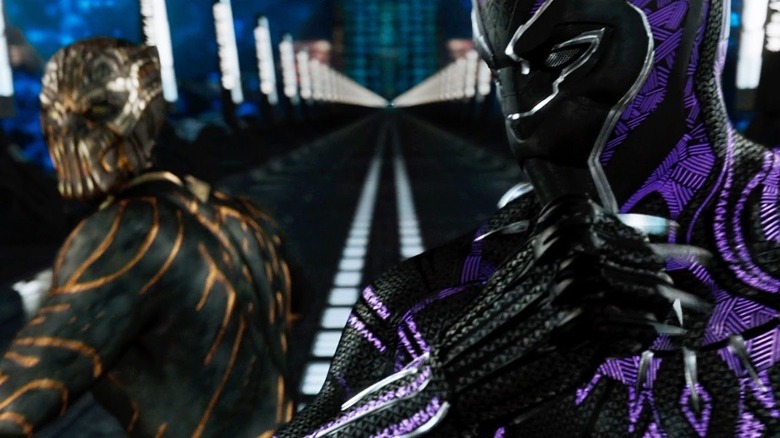Why So Many VFX Artists Are Fed Up With Marvel
A steady trickle has grown from a stream to a raging flood — and is now threatening to burst right through the dam.
Those who've spent any amount of time online (and especially in certain "Film Twitter" circles) can't possibly have missed the growing backlash against the look and feel of blockbuster movies in recent years, with the Marvel Cinematic Universe front-and-center of this growing controversy. Too often, trailers and other marketing materials will proudly boast shots with noticeably incomplete or unseemly-looking visual effects (VFX). "Thor: Love and Thunder" quickly came under scrutiny for the unconvincing digital helmet replacements covering Natalie Portman and Chris Hemsworth's faces, and more recently, the latest "She-Hulk" trailer hardly improved on the roundly-mocked uncanny valley inherent in the design and VFX work used to bring Tatiana Maslany's Jennifer Walters to life in her big, green form.
For the most part, we've largely had the word of anonymous subreddits or the stray viral post on social media (or, rarely, the occasional regretful comment from the creative team) pointing towards the root of the problem rather than the obvious symptoms. But thanks to an eye-opening and quite damning new report, the reasons behind such widespread issues is quickly becoming clearer and clearer. This isn't a case of simply "lazy CGI" or allotting the proper amount of budget to each production. Instead, this appears to be a systemic issue betraying a shockingly reckless and scattershot filmmaking process that doesn't allow for the time, space, or effort for overworked VFX artists to submit the best work that they know they're capable of.
Overworked and underpaid
In a new and rather explosive Vulture report, reporter Chris Lee chronicled a conversation he had with an anonymous visual effects artist who has worked on several Marvel productions over the length of their career. Confirming much of what has largely been speculated, the artist detailed how much pressure their colleagues are constantly under as Marvel Studios in particular wrings as much from their VFX vendors as humanly possible — and sometimes even more than that. As the VFX artist describes the working conditions when under contract with Marvel on a particular project:
"When I worked on one movie, it was almost six months of overtime every day. I was working seven days a week, averaging 64 hours a week on a good week. Marvel genuinely works you really hard. I've had co-workers sit next to me, break down, and start crying. I've had people having anxiety attacks on the phone."
The studio's improvisational approach to filmmaking may be convenient to the reshoot-happy executives in charge, but it's significantly less so for those under the gun who have to meet the relentless and oft-changing demands of those higher up in the chain of command. According to the source:
"The other thing with Marvel is it's famous for asking for lots of changes throughout the process. So you're already overworked, but then Marvel's asking for regular changes way in excess of what any other client does. And some of those changes are really major. Maybe a month or two before a movie comes out, Marvel will have us change the entire third act. It has really tight turnaround times."
Meet the deadlines ... or else
As if pushing the many, many VFX vendors at the disposal of Marvel to engage in "crunch culture" wasn't bad enough ("Thor: Love and Thunder" alone is credited with hiring several different VFX vendors, as is usual practice with these movies), the VFX artist that Vulture spoke to goes on to describe how the studio displayed a vindictive streak when certain vendors failed to deliver on-time under such demanding circumstances. According to the source:
"The studio has a lot of power over the effects houses, just because it has so many blockbuster movies coming out one after the other. If you upset Marvel in any way, there's a very high chance you're not going to get those projects in the future. So the effects houses are trying to bend over backward to keep Marvel happy. [...] One visual-effects house could not finish the number of shots and reshoots Marvel was asking for in time, so Marvel had to give my studio the work. Ever since, that house has effectively been blacklisted from getting Marvel work."
The VFX artist points to multiple different factors, including the process of "underbidding" that encourages vendors to lowball each other in the hopes of getting hired by Marvel. This inevitably results in staff shortages (instead of 10 artists on a team for a non-Marvel blockbuster, it would be 2) and more work heaped on a fewer number of employees. Only a cursory look at the Twitter feeds of established VFX veterans such as Todd Vaziri shows just how difficult and time-consuming their jobs can be at the best of times.
Under the circumstances described here, it's a wonder that the VFX work in a given Marvel production looks even half as good as it does.
'Pixel-f****d
Perhaps one of the biggest reasons behind this pervasive VFX issue, as described in the Vulture report, goes back to the way Marvel tends to approach the basics of their filmmaking process in the first place. Rather than fine-tuning a screenplay at the earliest stage and meticulously storyboarding the movie as envisioned, Marvel films have a propensity of being ushered into production with several major facets still up in the air. While reshoots aren't a problem in and of themselves, the indecisive mindset where entire swaths of the film can be overturned and rewritten on the fly leads to exactly the kind of unfavorable working conditions that seem to be plaguing many of the vendors working with Marvel. As the anonymous VFX artist puts it:
"I remember going to a presentation by one of the other VFX houses about an early MCU movie, and people were talking about how they were getting 'pixel-f****d.' That's a term we use in the industry when the client will nitpick over every little pixel. Even if you never notice it. A client might say, 'This is not exactly what I want,' and you keep working at it. But they have no idea what they want. So they'll be like, 'Can you just try this? Can you just try that?' They'll want you to change an entire setting, an entire environment, pretty late in a movie."
None of this should come as a major surprise to fans who have been following along with several of the recent Marvel movies — "Avengers: Endgame" famously had its VFX vendors digitally replace the time-travelling outfits that the Avengers donned during several major action sequences, for instance. But while usually touted as a filmmaking strength, the reality couldn't be more different for VFX artists.
A directing problem
Though this may be a problem persistent throughout blockbuster filmmaking in general, another familiar criticism lobbed towards the Marvel movies in particular concerns the hiring of relatively inexperienced indie filmmakers to helm massive productions that require an intimate knowledge of how best to put VFX artists (and every other department involved in filmmaking, for that matter) in the best possible position to succeed. According to the anonymous VFX source:
"The main problem is most of Marvel's directors aren't familiar with working with visual effects. A lot of them have just done little indies at the Sundance Film Festival and have never worked with VFX. They don't know how to visualize something that's not there yet, that's not on set with them. [...] The other issue is, when we're in postproduction, we don't have a director of photography involved. So we're coming up with the shots a lot of the time. It causes a lot of incongruity. A good example of what happens in these scenarios is the battle scene at the end of 'Black Panther.' The physics are completely off. Suddenly, the characters are jumping around, doing all these crazy moves like action figures in space. Suddenly, the camera is doing these motions that haven't happened in the rest of the movie. It all looks a bit cartoony. It has broken the visual language of the film."
The VFX artist sums up the issue thusly: refining the filmmaking process in general would benefit VFX artists, and moving to unionize the VFX industry so they may enjoy the same protections and benefits as most others in the film industry do is the only logical step forward. Ultimately, respect and fair treatment for the most underseen workers on a movie won't happen overnight. But reports like these go a long way towards creating awareness, at the very least.
